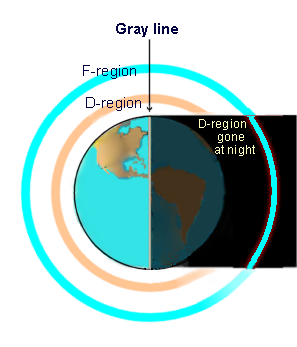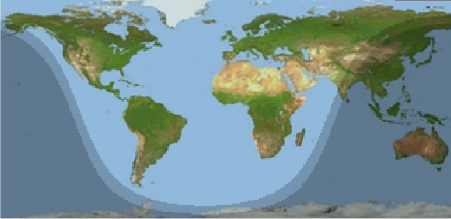
 What is "Gray Line" Propagation?
What is "Gray Line" Propagation?
American: Gray / British: Grey
The "grey line" refers to the Earth's twilight zone, a boundary between day and night, and is used in radio communication to describe specific propagation conditions.
 The height of the F and D regions is exaggerated in comparison to Earth dimensions. |
An example of a "gray line" map ↗ |
The twilight zone is a "sweet spot" for HF radio transmission, allowing signals to travel further with less attenuation due to the refracting regions E and F, while the absorbing region (D) is inactive.
Greyline propagation can be particularly advantageous for long-distance communication, as it allows radio waves to travel further than they might otherwise. However, it is a relatively short-lived phenomenon, lasting only a few hours each day as the Earth rotates and the gray line moves. In addition, the specific conditions of the ionosphere can affect the behavior of radio waves during greyline propagation, and not all frequencies may work equally well during this time.
Amateur radio operators often take advantage of greyline propagation to make long-distance contacts with other operators around the world. Some operators use specialized software or tools to help identify when the grey line is passing over their location, and to determine the best frequencies and modes of propagation to use during this time. Overall, greyline propagation is an interesting and useful phenomenon that can provide unique opportunities for long-distance radio communication.
Back to the main page: why is radio propagation better along the "gray-line", as well as in-depth tutorial about the propagation of sky waves. See also an index of terms for HF Radio propagation.
shows near-real-time indices and explains what the terms mean.